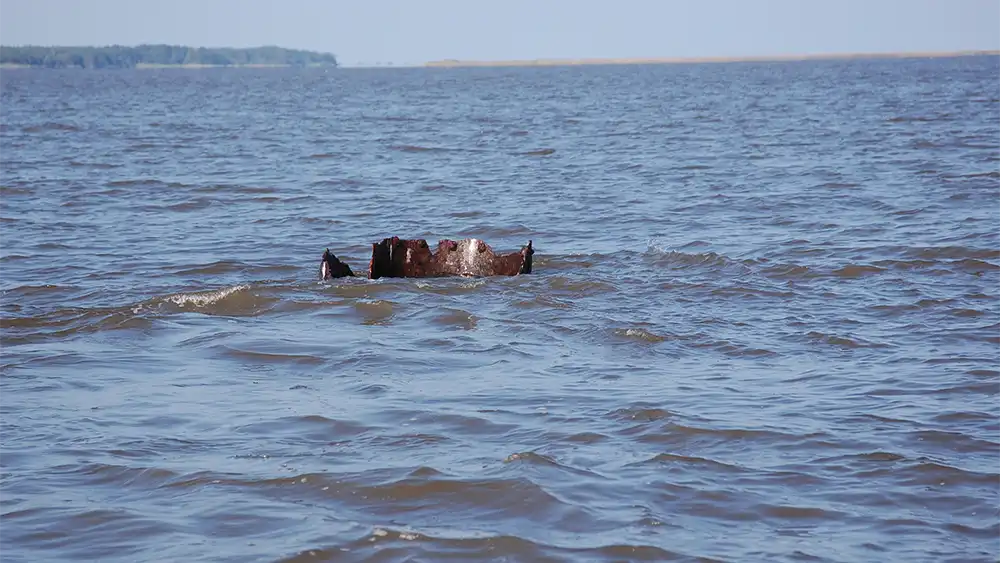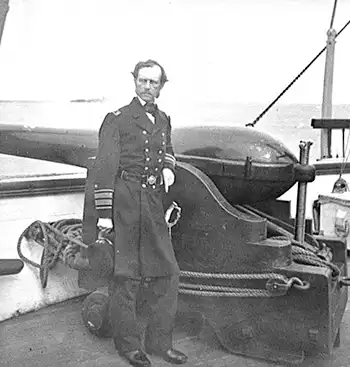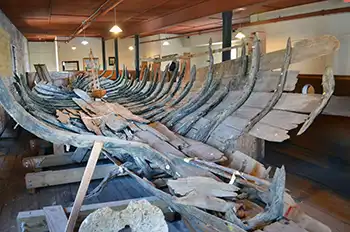
Originally designed as a ferry to commute passengers up and down the coast of Maine and once a week into Boston, the steamship Harvest Moon was acquired by the U.S. Navy in 1864. Assigned to the South Atlantic Blockading Squadron, the USS Harvest Moon prevented Confederate vessels from delivering supplies to the ports of Savannah, Charleston and Georgetown.
Sabotage at Sea
According to historian Paige Sawyer, Admiral John Dahlgren was stationed on the Harvest Moon, which was in port when Charleston surrendered on Feb. 17, 1865. Upon hearing Georgetown was ready to capitulate as well, Dahlgren and his crew traveled on the Harvest Moon up the coast to the port city where they delivered surrender papers to town hall, declaring freedom for all enslaved people in Georgetown County. By the time the transaction was completed, it was too late in the day to return to home base in Charleston, so the ship anchored in nearby Winyah Bay off of Battery White, an abandoned Confederate fortification.

Sawyer said that same evening, upstairs in the old Kaminski Hardware shop on Front Street, two Confederate soldiers were busy packing several mines with gunpowder. Under the cloak of darkness, on an outgoing tide, they rowed out into the bay and weighted the torpedoes 2 feet under the water’s surface.
The next morning, on March 1, Dahlgren gave orders for the Harvest Moon to be dispatched to Charleston. Within minutes of embarkation, the ship hit one of the Confederate mines, which according to the admiral, as cited in George C. Rogers Jr.’s book, “The History of Georgetown County, South Carolina,” blew a 10-by-12-foot hole through the starboard quarter, sinking the ship in 5 minutes in 12 feet of water. The only fatality was a steward named John Hazard, 30, who Sawyer said was serving the admiral coffee when the floating torpedo struck. Dahlgren and the rest of his crew were transferred to the tug Clover without further injuries.
On April 21, 1865, according to the Naval History and Heritage Command, “Harvest Moon was stripped of her valuable machinery and abandoned.” Entombed in pluff mud, the Harvest Moon remains forever stuck in Winyah Bay, with the top of its smokestack protruding above the water. To catch a glimpse of the ship, visit lowcountrytours.com.
For more than 100 years, the identity of a ship wrecked off the coast of Cape Romain remained unknown and local divers referred to it simply as the “Anchor Wreck.” According to the curator of the South Carolina Maritime Museum Justin McIntyre, the mystery was solved in 2007 with the discovery of a New York Times article published in February 1905 regarding a boating incident in South Carolina on Feb. 4 of that year.
Everything But the Propeller
Due to a winter storm with strong gusts, visibility was limited and on its return to New York a whaleback called the City of Everett slammed into the Leif Eriksson, which was en route to Philadelphia to deliver sugar from Cuba. Within minutes the ship sank and its crew was welcomed aboard the City of Everett. Because intense winds had downed telegraph lines in Charleston, information about the wreck never reached South Carolina.
To preserve the vessel’s history, Lowcountry Marine Salvage rescued an iron propeller from the wreckage weighing over 22,000 pounds and measuring 14 feet in diameter and donated it to the South Carolina Maritime Museum, where it remains propped against the side of the building. To learn more about Georgetown’s shipwrecks, visit the museum, located at 729 Front St. or online at scmaritimemuseum.org and youtube.com/watch?v=59nWmLYz3cA.
Oldest Recovered Wooden Vessel in America

In 1970, divers discovered a sunken ship named the Brown’s Ferry Vessel after the location where it was found. After years of effort to recover the vessel, which was laden with 25 tons of bricks made on a plantation, the remains (circa 1730) were stored for 10 years at a preservation facility outside of Columbia. Although Brown’s Ferry is the oldest recovered wooden vessel in America, no one knows who owned the boat or where it came from, according to former member of South Carolina’s House of Representatives and chairman of the board of Georgetown’s Rice Museum, Vida Miller. Along with the Rice Museum’s executive director, Jim Fitch, Miller helped secure funding through the state’s budget and other fundraising endeavors to raise money for the recovery of Brown’s Ferry and its installation on the third floor of the museum.
To learn more about the Brown’s Ferry wreck, visit the Rice Museum, located at 633 Front St. in Georgetown, or explore ricemuseum.org.
By Sarah Rose


Leave a Reply